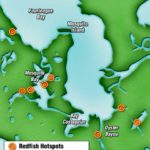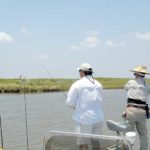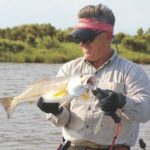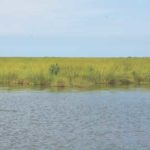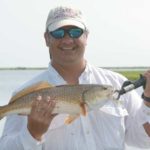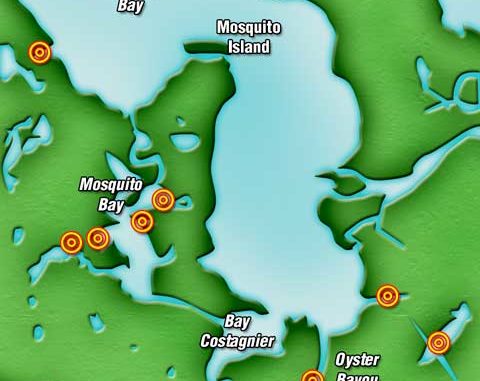
Don’t let the name scare you away. You’ll swat more redfish than bugs at Mosquito Bay.
In one fluid motion, I made a cast toward the little trenasse that emptied into the canal we were fishing, located just past the mouth of Mosquito Bayou on the northeast side of Mosquito Bay.
Also in fluid motion, I raised my leg in crane-like fashion, and used the top of my foot to itch whatever decided to bite the back of my calf while I wasn’t looking.
What was it that made three guys get together and motor 45 minutes down the Atchafalaya River and across Four League Bay to a placed called Mosquito Bay inside Point Au Fer Island, without any bug spray?
Let’s just say it was for different itches to scratch.
For avid angler Ray Beadle, it was a chance to “chase and hook them mules,” as he fondly says about redfish.
For Johnny Cremaldi, who owns a CPA firm in New Orleans but grew up in St. Mary Parish, it was an opportunity to learn some new redfish ground.
For me, it was making another trip into an area that I previously had some success. I was anxious to get reacquainted with some of the little lakes, canals and bayous that surround the bay known to produce some nice catches of fish.
But I was more anxious to feel the protest of a strong-willed redfish, straining the limits of my rod and reel.
“Flores, check in the bottom of my bag. I know I brought some (bug spray),” Beadle implored, showing concern but not enough to dig into his bag to find it and help a friend out.
He was too busy throwing his spinning bait into the trenasse too. His sympathy certainly was not empathy, because he never stopped chunking his lure. But, then, neither did Cremaldi, nor did I. I’d just have to scratch.
Good thing, because moments later, Beadle was working over one of his mules.
“I forgot the net!” Cremaldi said. “I knew there was something I was forgetting.”
What makes Mosquito Bay and the surrounding area so good is diversity. In one day, you can fish deep, main bayous with heavy current flowing through them, bayou and canal banks, little trenasses that empty into the bayous and canals, little passes that flow over shell reefs, isolated shallow lakes and ponds and man-made structures such as rock embankments, weirs and even debris left over from the storms of 2005.
The deep bayous typically hold 20 feet or more of water. In nearby Oyster Bayou, where the current boils out on a strong falling tide, the depth is 40-plus feet in some places. Bull reds are known to work these depths along with black drum.
Tactically speaking, fishermen will want to use heavy tackle with no less than 20-pound-test line and 4-ounce pyramid sinkers to hold the bait on the bottom. This is where big fish lurk, and it calls for a big bait, such as a half or whole crab fastened onto a Mustad or Gamakatsu 4/0 circle hook.
True, there may have to be some culling before you hook a bull red. Heavy-bodied black drum, like red drum, enjoy a served-up meal of fresh crab. But, given the chance, you’ll be in for the fight of your life, and your one redfish over 27 inches will give you all the wrist-wrenching, forearm-burning action you’ll want for your big keeper.
As deep as some of the main bayous are, many of the lakes, ponds and passes that make up the peripheral geography surrounding Mosquito Bay are shallow by comparison. Moreover, weather patterns influence these areas tremendously, but shouldn’t cause anyone to opt out of a day on the water in the region — unless severe, of course.
Such was the case on the trip we were making. A summer weather front had moved in with winds out of the northwest. Crossing Four League Bay was slightly bumpy with a light chop on the water, and noticeably, the coloration was poor.
Faced with the conditions, not to mention coming too far to go back, we adjusted our tactics and approach.
“One of the things about fishing Mosquito Bay that I have learned over the years is the impact of weather on water conditions,” Beadle said, as he made several precise casts into the trenasse.
“When the wind has all of the water stirred up and the bottom muddy, you can always move to the back side of the bay, and fish canals and bayous where the wind isn’t a problem and the water color is pretty and green. It’s easier for the fish to get a longer visual strike to hit the bait when the water is clear, rather than rely on smell when using a shrimp on the bottom.”
We looked for and found good, clear, fishable water, maximizing what was available. The fish also were scattered on our outing, causing us to troll more. We picked up our fish here and there, but other than the occasional concern over hoping we had enough charge on the batteries, this was fine. None of us had any scheduled plans or other places we needed to be.
Lazily, we worked much of the east side of the bay, fishing every point, structure, drainage and calm area that looked good. We focused on running baitfish and looked at what the birds were doing.
Beadle, being a seasoned bass fisherman, is exceptionally good at casting at moving targets. He had a knack for getting out in front of the swirls before Cremaldi and I could.
Sight fishing in Mosquito Bay is productive, but takes quite a bit of time. We, essentially, utilized this tactic only when we absolutely had a bead on a red.
In one extremely shallow canal, I watched Beadle work an area, transecting it like someone throwing a drag trying to locate something. He eventually enticed the red we saw to strike.
Faced with the muddy condition of the open water, we preferred fishing the clear and slightly stained water of the bayous with the moving tide. The idea was to find a point, throw at it. Find a trenasse, throw in it. See some structure, throw around it. See some sheet pile blocking off a pipeline crossing, throw along the front of it. But, no matter what, keep throwing.
Redfish anglers should always fish around structure when the opportunity presents itself.
A semi-submerged damaged pipe assembly looked entirely too good to pass up, and Cremaldi worked a popping cork with a shrimp attached around the structure. We actually saw the fish beforehand swirling, as we trolled the bank toward the location.
Cremaldi made good on his cast, because he had the biggest fish of the day on. Unfortunately, the big bull made a beeline underneath the structure, and something cut the line, leaving all of us briefly with that bummed dumfounded feeling. It’s always that way when you lose a fish you felt you should have had.
One thing that played to our advantage was all three of us were using different baits, trying to entice fish. While Beadle and I preferred to use artificial baits, Cremaldi was all-natural.
“I like a big shrimp under a popping cork,” he said. “It’s just a proven, standard way to fish redfish that catches. But I’ll use artificial baits too, especially if you find a pattern with artificial bait that seems to be working on them.”
Redfish anglers should plan to come to the region with a good arsenal of spinnerbaits, like Red Fish Magic; vibrating baits, like Stanley Saltwater Swim Jigs, Johnson weedless spoons and Rat-L-Traps; and plastics, like Deadly Dudleys, H&H Cocahoes and Stanley Saltwater Wedgetails.
But when it comes to all-around fishing success, nothing beats Cremaldi’s shrimp in all conditions.
“When the water is messed up, you have no choice but to use shrimp,” Beadle said. “When the water’s like cocoa, the fish have to rely on smell to find your bait, rather than sight when the water is clear.”
Geographically, Mosquito Bay also places you within 10 to 15 minutes from other productive areas. To the west is Pelegrin Cut, which is worth checking out. As an added bonus, anglers can pick up speckled trout fishing the mouth of the cut where it opens to Four League Bay. The water in the cut is approximately 20 feet deep. Rigging up to fish on the bottom with shrimp can be productive.
Big Oyster Bayou and Old Oyster Bayou are proven standbys in the area to the east of Mosquito Bay. The canals off Big Oyster Bayou lead to two lakes that produce catches of reds, and trolling the banks of Old Oyster Bayou from the mouth of Four League Bay to the canals also is excellent when conditions are favorable.
There are a number of weirs and sheet pile bulkheads at pipeline crossings in the region. A Carolina-rigged shrimp on the bottom is a good method for testing these structures for redfish. I like to use a 1/0 kahle hook on the business end of this set up.
Mosquito Bay and the surrounding region offer diversity to anglers who enjoy trolling with artificial baits or simply sitting on anchor fishing shrimp on the bottom. Regardless of how you prefer to catch reds, the area provides you with plenty of opportunity to utilize your own proven tactics.
